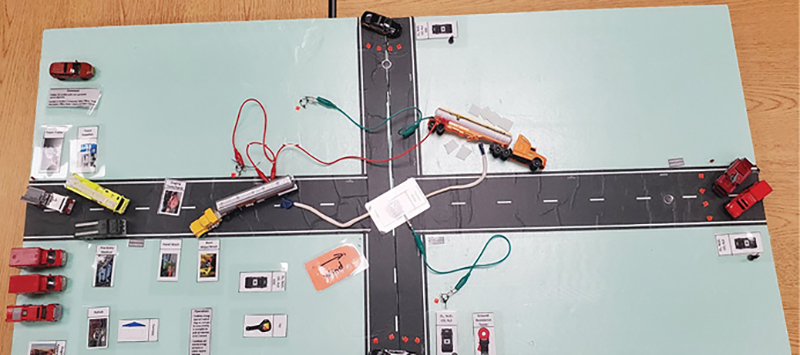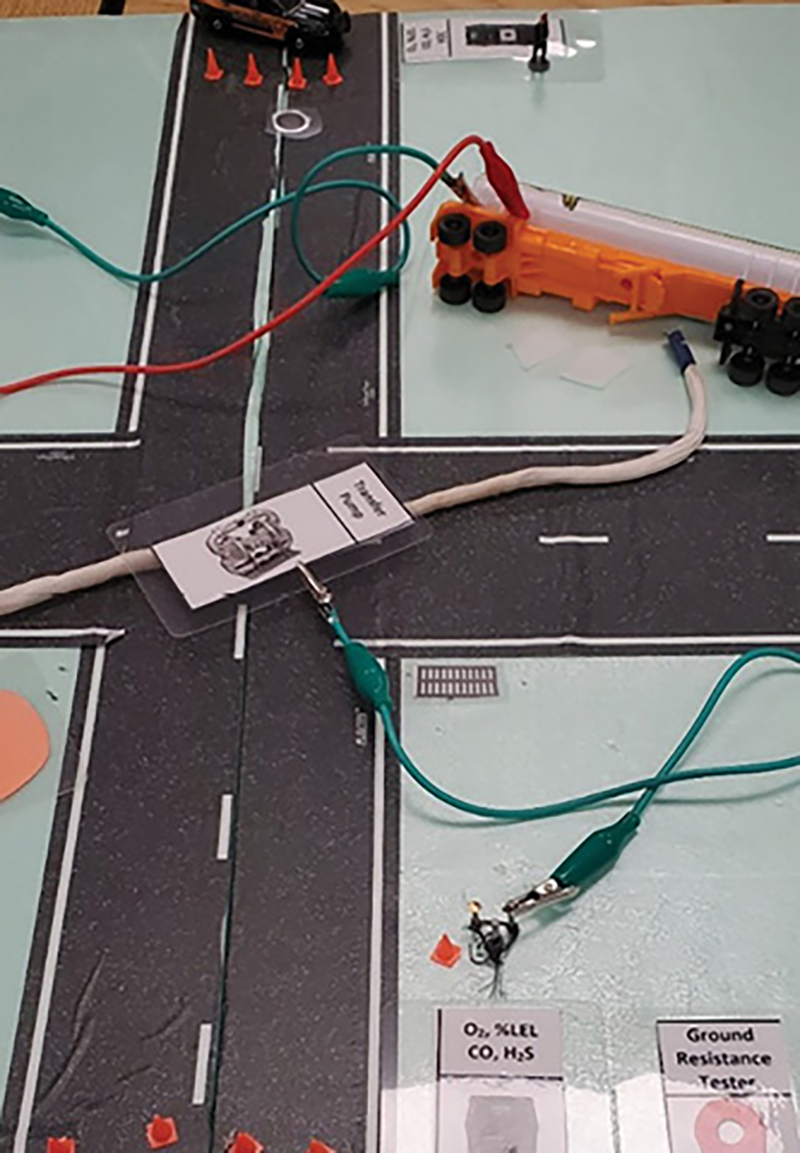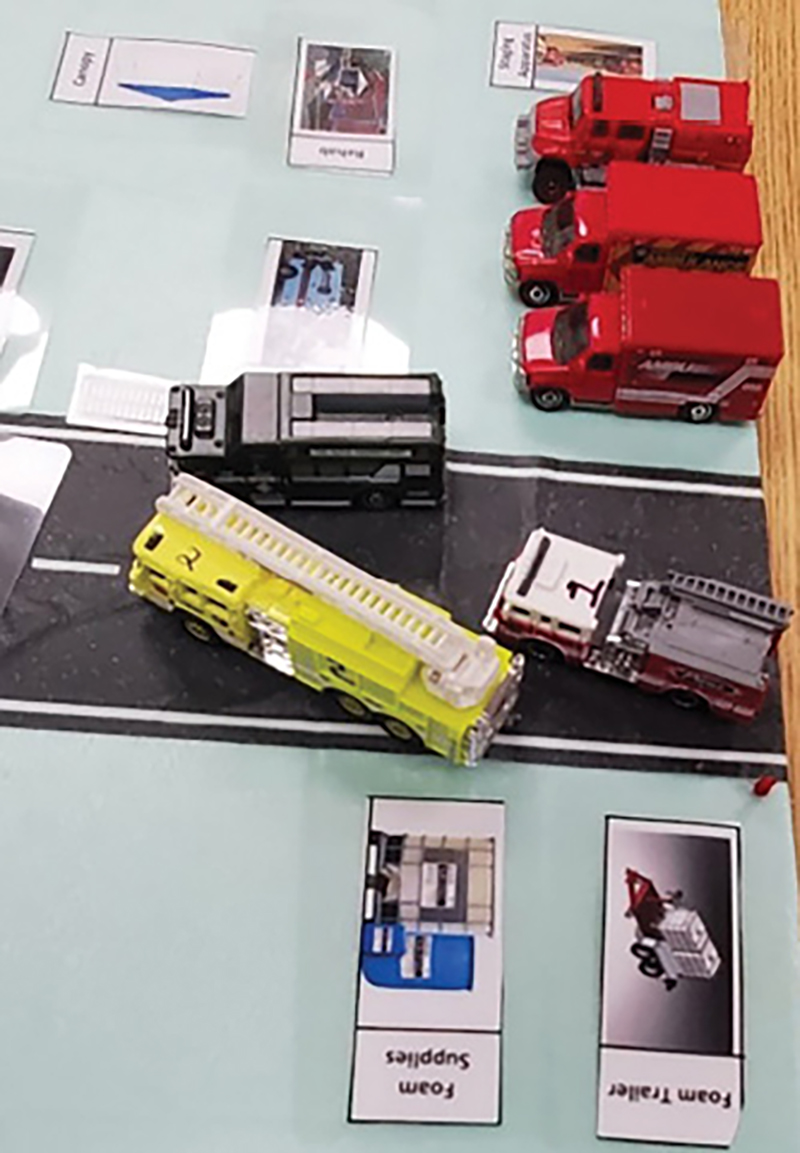By Jerry Knapp and James A. Leer
Exercise-based tabletop models are a very effective method to provide initial and refresher training for your firefighters. This article will show you how to use them to provide clear direction for your firefighters. These models are essentially 3-D pictures of what you want them to do. We will use two examples. First, we will show how to train your firefighters and officers on a new standard operating procedure (SOP) for natural gas emergencies using tabletop simulations. Second, we will examine how a simple home-built model can be used to train and perfect a complicated hazardous materials task, grounding and bonding.
- Share Your Fire Scene Challenges To Avoid Chaos
- Tactical Procedures for Explosive Gas Alarms
- How to Plan and Execute a Large-Scale Training Drill
- The Importance of Realistic Firefighter Training
The models do not have to be sophisticated. The examples below are intentionally simple to avoid overthinking the operation and designed to achieve complete success in training and practicing standard, strategic, and tactical operations.
Another benefit of using models is that during practice simulations you will highlight strengths and weaknesses in your plan. You can also find better, more effective ways to resolve the situation. The tabletop also provides some fresh looks at what actions you want firefighters to take when the situation goes bad or how to prevent them from getting into those situations. Let’s see how using a model as a training tool can vastly increase your fire department’s effectiveness.

(1) Leak Street is a simple model that allows officers and members to practice and perfect new tactical procedures. Circles represent sewer manholes and squares are storm drains in this typical residential street. (Photos courtesy of authors.)

(2) It was developed from tactical lessons learned during the after-action review following a near double LODD at this natural gas leak and explosion.
New Tactical Procedures
The Leak Street model and the three-hour program it is built to support were the products of numerous after-action reviews from a routine gas leak when a building exploded, resulting in what was nearly a double line-of-duty death (LODD) (photos 1, 2). We learned that three factors (failure chain) came together for this nearly tragic incident.
- Our background knowledge of tactics for gas (natural gas and propane) leaks is limited to a few paragraphs in both firefighter and officer training curriculums.
- Most firefighters in first-due units (not specialty units like rescue or hazmat) are not well-trained in using and understanding air-monitoring instrument readings.
- We have found from teaching our program across the nation that most departments do not have aggressive, industry best practices procedure-based responses for the seven types of natural gas emergencies. This results in officers doing the best they can based on field experience and training, which may vary greatly from officer to officer. If the local utility is cooperative, it may provide the next or high level of training but certainly not what is needed for safe and effective response actions by fire departments.
Using the model gives trainees time to think both strategically and tactically as well as time to digest and discuss the new response procedures in a realistic scenario. The overhead view provides an excellent clear picture of the entire response and allows group interaction during development, testing, and training.
We use this simple model to help trainees use their new tactical response to explosive gases SOP so they can visualize key points of the new SOP we are putting into practice for field units. It is an intentionally uncluttered model of a suburban residential street.
The tabletop model is the third phase of teaching officers and firefighters gas industry best practices for response to natural gas and propane emergencies. We first introduce the SOP in a didactic setting, which is immediately followed by walking through the SOP using overhead photos and gas meter readings of a similar gas leak situation. The model shown here is another opportunity to practice response procedures before trainees are taken out to our full-scale Leak Street at our fire training center in more of a testing situation.
Using Models
The purpose of this teaching technique is to familiarize, teach, and test the procedure or practice, not to embarrass, test, or intimidate a trainee in front of peers or others. We ask for volunteers to play the roles of incident commander (IC), first-due engine and truck chauffeurs, safety officer, and crew members to use combustible gas detectors. The gas detector we use for the tabletop can receive readings from an exercise controller using a tablet.
The trainees stand around the model and give direction to the players. Trainees are instructed to bring the SOP we gave as a handout to use as a checklist. For example, the IC’s responsibility is to pick his crew and his command post location. As they are assigned, the engine and truck chauffeurs get a scale model engine/truck, the safety officer gets red twine so he can indicate the kill box (area in which death/injury is expected from the blast wave and debris), and the meter person gets the meter.
Trainers describe the dispatch information—in this case, an odor of gas outside 3 Leak Street. The IC sets his command post location and is done. Engine and truck drivers are told to position their vehicles based on the SOP. Trainers select one person to read the SOP and then ask the group an open-ended question such as the following: Where do you park the rigs? What buildings do you survey first with your explosive gas detector? What would anyone do differently at this point? A discussion occurs to resolve any issues the trainees may have.
The SOP contains strategic and tactical objectives. The SOP reader reads each objective and the lead trainer asks, was this done? If yes, they move on to the next one. The safety officer is asked to put the string around the kill box. While he is doing this, we discuss that at this point he has very little information to go on, so this is his best guess. The two remaining strategic objectives are read (#3 and #4 below).
IC Strategy
- Establish command post, assign safety officer and situation unit leader.
- Estimate kill box.
- Determine if gas is migrating underground to nearby buildings.
- Request dispatch to check with the utility if this is a known Class 2-3 gas leak.
Tactical Actions
- Check buildings (front door and point of entry) and subsurface structures closest to the leak source first; evacuate as necessary.
- Check buildings on four sides of odor site using inside gas leak procedures.
- Check subsurface structures and buildings on all sides of the leak site until readings are 0% lower explosive limit (LEL).
- Open manholes to vent gas if readings exceed 25% LEL in manholes.
Tactical actions are when the discussion gets going. The SOP reader reads the first action and the trainer asks the group, where do you want him to take gas readings? He is directed to put the gas detector at both the front door and then notionally to the point of entry of the pipes in the basement. The trainer with the tablet sends scenario-specific and appropriate readings and then asks what the group wants both the IC and the crew with the gas meter to do. Options include evacuating the occupants if the department’s action level have been achieved, continuing on to the next house, and calling additional alarms.

(3) The model is another opportunity to practice response procedures before trainees are taken out to our full-scale Leak Street at our fire training center.

(4) Tactical and strategic discussions get lively when trainers send gas readings to firefighters, simulating taking explosive gas readings on Leak Street.
This process is repeated for the remaining tactical objectives. During the exercise, we allow open discussion of alternatives and discuss why the SOP has the specific actions for this specific type of explosive gas release. Since these are veteran firefighter taking this training, these discussions are often specifically relevant to their department’s staffing, equipment, and so on. The result is that they leave the training with familiarization and practice with their new SOP. Even if they use different strategic and tactical objectives, they have an excellent starting point to improve their standard tactical response to an explosive gas release.

(5) A simple model is an excellent training tool to familiarize yourself with, practice, and perfect hazmat operations like grounding and bonding.

(6) The use of multiple grounding rounds rods to achieve desired ground resistance.

(7) 550 cord, wires, and cards represent hoses, grounding, and transfer equipment.
Active Training
Firefighters learn by doing. A tabletop training model allows for student learning in two ways. First, the instructor uses it as a hands-on interactive training aid as opposed to “Death by PowerPoint®.” The instructor can demonstrate and explain essential steps or tasks in a controlled classroom setting with fewer distractions and not be impacted by inclement weather or other distractions. Second, interactive scenarios allow the students and instructors to interact (with each other and the scenario) through role playing (nonthreatening) and discussion in a less stressful and controlled environment. The tabletop allows for a compact overview of a task or operation as opposed to being spread out on the drill ground. The training method can be cost-effective and requires less setup and tear-down time, which allows more scenarios and incident-based factors to be presented to the students.
The instructor can use interactive scenarios to identify learning gaps and to reinforce essential tasks and safety protocols. The method allows for frequent training pauses to make corrections, discuss options, answer questions, or realign students if they should veer away from the training objectives. Finally, the learning environment helps the students to become more comfortable and confident when performing a task or operation on the drill ground—for example, using a tabletop model to simulate a house fire that involves multiple operational tasks such as size-up, apparatus positioning, handline placement, supply line from a hydrant, and utility control.
Another excellent application of a tabletop model is for complex hazmat scenarios such as grounding and bonding during flammable liquid transfer operations.

(8) Bonding and ground of the containers and transfer pump. The tabletop allows for discussion of testing the ground resistance with a ground resistance tester, detection/monitoring flammable atmospheres, and transfer operations.

(9) Staging and placement of apparatus, establishing incident command and rehab area, and premedical evaluations.
Grounding and Bonding Material List
- Two two-foot by two-foot sheets of foam insulation. This allows for a more compact setup for travel.
- Roadways can be simulated with painting on the insulation board. Another way to simulate the streets is adhesive tape with the street design that is used for kids play areas.
- Eleven finishing nails to simulate grounding rods. This will allow for individual ground points for the damaged container, transfer container, and transfer pump. Two nails can be used for demonstrating the placement of the ground meter test rods. Additional nails at each grounding point can be used to discuss the addition of grounding rods to achieve the desired ground resistance.
- Three pieces of wire to demonstrate interconnected multiple grounding rods at each of the three grounding points to improve the ground resistance.
- Four pieces of wire with clips to represent the three grounding wires and one for the bonding wire between the damaged and transfer containers. Several colors of wire can used to help differentiate the connections and wires.
- Two toy tanker trucks to represent the damaged and transfer containers.
- Various toy fire, EMS, and police vehicles to represent the responding units. These can be used to establish hazard and traffic control zones, fire suppression, and so on. Several miniature traffic cones can be used to demonstrate their application with establishing hazard and traffic control zones.
- The transfer pump can be simulated with a small box and pieces of rope can represent the transfer hose system between the pump and the containers.
- Small sections of absorbent pads can be cut to simulate the application and placement of absorbent pads. A small bag of sand can be used to simulate diking and damming of released contents.
- Keeping to the compact size of the tabletop model, operational task cards (business card size) that are laminated are used to support verbal indication of strategic and tactical actions to visually indicate implementation and location or area of the task. These cards can show words (i.e., staging area) or photos that indicate an operational task. The bonding and grounding tabletop uses cards to indicate detection/monitoring points and application of the ground resistance meter.
Demonstrate
- Placement of each of the three grounding points in relation to each container, wind direction, flammable atmosphere. The foam insulation is for the nails to be pushed into.
- The testing of each grounding point with a ground resistance meter.
- Placement and interconnection of additional grounding rods at each grounding point to achieve desired ground resistance.
- The order of connection of the grounding clamp and wires, bonding clamp and wire, and transfer pump hoses.
- Discuss the importance of allowing for relaxation of the system before starting transfer operations.
- Discuss tasks to be completed during transfer operations such as checking connections and detection and monitoring.
- Discuss the order of removing the grounding and bonding system once transfer operations have been completed.
Tabletop training models have been used historically and very successfully by our military (i.e., sand tables) as an effective way to convey complex, dangerous tactical operations. Models allow for more realistic, active, and participatory learning through scenario-based role playing in which students are given a task or an assignment and can practice it in a nonthreatening environment.
Jerry Knapp is the chief of the Rockland County (NY) Hazmat Team, has a degree in fire protection, is a 46-year veteran firefighter/emergency medical technician (EMT) with the West Haverstraw (NY) Fire Department, and is a former paramedic. He served on the technical panel for the UL residential fire attack study. Knapp is the co-author of two Fire Engineering books: House Fires and Tactical Response to Explosive Gas Emergencies. He is the author of numerous articles in Fire Engineering and state, national, and international fire service trade journals and the author of the Fire Attack chapter in Fire Engineering’s Handbook for Firefighter I and II. He retired from the U.S. Military Academy, West Point, where he served as the plans and operations specialist at the Directorate of Emergency Services.
James A. Leer is an insurance senior loss control consultant and a 35-year veteran of the fire service. He is a firefighter with the Somerset (PA) Volunteer Fire Department and a hazardous material technician for the Somerset County (PA) Hazardous Materials Response Team. He is a Pennsylvania local level state fire instructor for 25 years and has an associate degree in fire science, a bachelor’s degree in safety management, and a master’s degree in safety sciences. He is a Certified Safety Professional® through the Board of Certified Safety Professionals.

